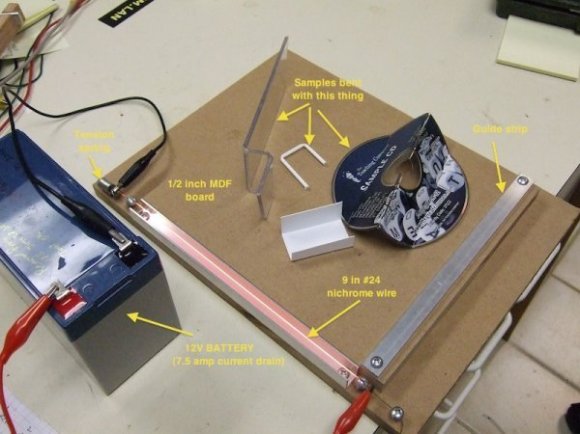
Regular reader [RoadWarrior222] has watched as we’ve featured several projects that show how to bend acrylic. But so far he hasn’t seen us cover his favorite technique developed by [Dale A. Heatherington] which uses a hot wire forming tool to make precise bends. The tool is simple to use plus it’s cheap and easy to build. It’s a great choice if you don’t have a heat gun, and it may be possible to make cleaner bends than other techniques.
The business end of the bending tool is the red-hot Nichrome wire running through the aluminum channel. That channel is used to protect the MDF and act as a spacer so that the wire doesn’t touch the acrylic. On the near side the wire is anchored with a screw, but on the far end it is kept taught by including a spring. The wire heats up as it is connected to a 12V battery, but since the heating is cause by the wire’s resistance it will only get red-hot in between the alligator clips providing power. To make sure your bends will be perpendicular to the edge of the acrylic there’s an aluminum guide strip on one side of the MDF platform.
You can salvage Nichrome wire from an old hair dryer. If you have any left over it’s great for other projects like building a CNC hot-wire cutter.
















I recently discovered a roll of about 3kg’s of nichrome wire. I’ll have to get around to making up one of these. Used a hot wire bender in high school, and it was brilliant.
When your done with that could you whip me up a toaster. ;)
Repurposed an old shrinkwrap sealer to do that. http://www.flickr.com/photos/quelabnm/8422052077
Oh, that’s cool. It’s a little hard to tell from the pic… how uniform are the bends? Are they smooth? If not, how do they look after flame polishing?
Nice, this could get useful!
the yellow labels are terrible especially the one over the white table for guide strip and can’t tell at all what the one on the left side says.. neat idea nonetheless
Tension spring **
a couple of years ago i was making an enclosure for high speed bullet photography and i bent some 1/4″ acrylic about 3 feet long of it with a propane torch and expecting it to fail it actually bent flawlessly!
tho somthing like this might be fun as hell!
“taut”, unless you’re trying to teach the wire something.
That’s a really nice build. Great attention to detail!
This is much the same as what we had at school 15 years ago! But with a regulated power supply. very very useful piece of kit.
Cool, I like it. Seems like a really easy build. Would love to have seen a video of it in action..
could do with a third guide axis in the vertical so your bends are to the same angle every time, but good stuff!
To prevent plexiglass from bubbling like that, use less heat. (maybe use an adjustable bench supply if you have one?)
if your using a table saw to cut the MDF, set it shallow and cut a slot for the wire under the top peice so it dosn’t have to go all the way around.
anyone done this with the wire OVER the work?